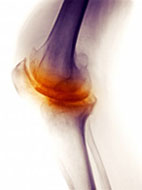|
PT Classroom - Hyaluronic Acid Injections as a Form of Treatment for OA of the Knees ׀ by Jill Bergersen, SPT |
|
Osteoarthritis affects more than 21
million people in the United States and is the most prevalent form
of arthritis seen (7). The knee, one of our body’s most critical
joints, is the most commonly affected. Over the last decade
hyaluronic acid joint injections have become a treatment option from
those suffering from pain and stiffness associated with
osteoarthritis of the knee (2). To better understand how these
injections provide relief, one must first understand the workings of
the knee joint, the purpose of cartilage, and the process of
osteoarthritis. The knee is one of the largest and most complex
joints of the body and is formed by the femur, tibia, and patella.
Cartilage is a rubbery tissue that lines the ends of the bones at
contact points to provide a cushion for the joint. Healthy cartilage
acts as a shock absorber in the knee joint and provides a cushion
for your bones as a means of protection against the impact forces
that act on the body through walking, running, and possible falls.
(3) Surrounding the knee joint there is a substance referred to as
synovial fluid that contain the very important hyaluronan. The job
of synovial fluid is to lubricate the joint by reducing the amount
of friction to provide maximum movement. Within the synovial fluid
is the hyaluronic acid which is a thick liquid that helps bones
glide smoothly against one another (4). As this critical substance
begins to break down, as seen in osteoarthritis, joint pain and
stiffness become present due to the reduction of lubrication within
the joint. In order for joints and cartilage to remain healthy there
must be sufficient synovial fluid produced which is ultimately
achieved through movement. As movement of the body is diminished due
to pain or stiffness, less synovial fluid is present therefore the
amount of lubrication decreases (1). A common analogy used to
describe this concept is to think of a stiff door and when the door
jams become dry the door doesn’t move as smoothly or easily. If you
apply some WD-40 to lubricate the door jam you can then easily move
the door. The same is true of your joints, when they become dry it
is more difficult to move and with less ease then if they were
properly lubricated. You must maintain your joints in the same way
you maintain your home!
Osteoarthritis in the knee is caused by wear and tear to the joint
leading to a gradual deterioration of cartilage. As the cartilage
continues to wear down, the joint space decreases and the bones
begin to rub together. In addition, the consistency of hyaluronan
becomes thinner (6). The most common signs and symptoms of OA of the
knee include joint pain, loss of mobility, stiffness, deformity, and
tenderness (3). There is no cure for osteoarthritis and overtime the
symptoms can become more severe indicating the importance for a
treatment that can improve mobility and decrease the progression of
OA. There are various treatment options that can yield different
results for each individual. Initially, a more conservative approach
is used by recommending patient’s to try exercise, physical therapy,
and NSAIDS to relieve their symptoms (5). If those methods prove
ineffective a more aggressive approach is used and one of those
treatments is a hyaluronic acid injection. This treatment is
noninvasive and is given in a series of weekly injections directly
into the cavity around the knee joint over a 3 to 5 week period (7).
The goal of these injections of hyaluronic acid into the knee joint
is to replace some of the natural supply that has depleted due to
the osteoarthritis. This added hyaluronic acid will increase
lubrication of the joint making mobility easier and reduce pain by
adding more cushion to the joint (7). The effects of the shot can
last between six to twelve months before the possible return of OA
symptoms.
Last revised: August 19, 2014
|
|
|
|
|








